Sol: 12
Summary Title: The return to Earth
Author’s name: Andrew Wheeler
Mission Status: Nominal
Sol Activity Summary: Overcast with rain showers clearing. No outside activities and so the time was spent finalising reports, archiving data and culling samples to be returned to their points of origin. One final series of analyses was carried out with the carbonate (CO3) concretions to determine whether the particles or the matrix are the CO3 material. Having crushed and sieved the material down to -63 microns, the relative levels of effervescence suggests that the matrix is the source of the CO3 that released CO2 in the presence of vinegar. Mind you n=2. When these analyses were completed, there was no more to be done. After lunch, our simulation was completed at 2:00pm local and we were on our way home to Earth.
Look Ahead Plan: Cleaning, tidying and packing for departure from MDRS and arrival home.
Anomalies in work: Nothing to report.
Weather: Overnight rain of 3.0 mm with temperatures ranging from 5C to 13C. Winds were light to variable.
Crew Physical Status: Nominal.
EVA: No EVAs for this morning.
Reports to be filed: Sol Summary, Journalist’s Report, Greenhab Report, Operations Report, Crew 291 Mission Summary.
Support Requested: Nothing to request.
Operations Report – February 2nd
SOL: 12
Name of person filing report: Scott Dorrington
Non-nominal systems: None
Notes on non-nominal systems: None
ROVERS
Spirit rover used: Not used
Opportunity rover used: Not used
Curiosity rover used: Not used
Perseverance rover used: Not used
General notes on rovers:
Summary of Hab operations: put notes here
WATER USE: ??? gallons (water tank filled prior to measurement)
Water (static tank): 360.5 gallons (depth 14.5”)
Static tank pipe heater (on or off): On
Static tank heater (On or off): On
Toilet tank emptied: no
Summary of internet: Nominal during comms window
Summary of suits and radios:
Summary of GreenHab operations:
WATER USE: 7 gallons
Heater: On
Supplemental light: 10pm – 2am
Harvest: 5x Tomatoes (36g), 3x peas (9g), 1x cucumber (24g)
Summary of ScienceDome operations: ScienceDome used to test rock for carbonates using vinegar.
Dual split: Nominal
Summary of RAM operations: Tools put away.
Summary of any observatory issues: None
Summary of health and safety issues: None
Questions, concerns and requests to Mission Support:
None.
Thank you for your support!
Mission Summary – February 2nd
Crew Members:
Commander: Andrew Wheeler
Health and Safety Officer: Steve Hobbs
Crew Scientist: Clare Fletcher
Crew Engineer and Green Hab Officer: Scott Dorrington
Crew Astronomer and Medical support: Rob Hunt
Crew Journalist: Alexander Tobal
Mission Plan:
Expedition Boomerang III saw an all Australian crew from the Mars Society Australia (MSA) bring a multidisciplinary team to MDRS to undertake our investigations. The mission objectives were divided into eight disciplines. In no particular order of importance they were: a) revisit geologically relevant analogue locations that can be shown to be appropriate to ISRU on Mars, b) deploy sensors to monitor the local environment including basic weather data, c) characterize mineralogy using a push broom VIS/NIR spectrometer, d) test the ability of a remote controlled rover to deliver the spectrometer over a variety of sloping ground and roughness, e) locating known prominent features for navigation purposes using trigonometry and dead reckoning rather than GPS and compass, f) revisit previously documented geological features for weathering and degradation with a view to develop strategies for geoheritage preservation, g) evaluate the set out of the MDRS and developed procedures with a view to inform the deployment of MSA’s Mars-Oz habitat in Australia and h) observe the current disposition of the Sun’s surface utilising the solar observatory.
Mission Activities:
The geology at the MDRS has been mapped at large scale by many crews over the years. EVAs were undertaken to revisit sites that have exposed minerals analogous to the minerals appropriate to ISRU on Mars. The two majority targeted minerals were gypsum and carbonate concretions. These locations were GPS located and saved to a format that can be transferred to multiple GIS software packages and used by following crews. Samples were collected and processed in the science dome to demonstrate usefulness. Secondary targets such as fossil beds and petrified wood (signs of preserved life) were also GPS-located when identified. Concurrent with these EVAs, the spectrometer was deployed both as a handheld tool and delivered by a remote controlled rover to the various sandstone, silstone and mudstone lithologies surrounding the MDRS. Samples were collected and returned to the MDRS for more controlled analysis and compared to the field data. Approximately 5GB of data was collected and continues to undergo processing.
Again, in parallel with these EVAs, angles and distances to prominent features were collected and positioned on a localised global map and tested for conformity to GPS positioning and compass bearings. Accuracy of positioning improved from approximately 100m to 40m but the majority of processing will be conducted away from the MDRS.
Two sensors were meant to be deployed at the beginning of the rotation and re-deployed at greater distance from the MDRS after an undefined number of days. One, a solar logger previously deployed during the FMARS15 mission in July/August 2023, was successfully positioned outside the science dome in view of the panoramic window. The battery needed recharging on four occasions. The second sensor, an electronic Stevenson Screen with multiple environmental sensors, was unable to be initiated due to circuitry burnout in the secondary battery pack and an untraced, electrical fault in the primary battery pack and was only ever deployed as a test of the setting up procedure rather than to collect weather data.
In 2005 and 2006, geomorphological features such as yardangs and mudstone and siltstone outcrops were located and photographed for follow-on studies. These were revisited, measured and re-photographed in an effort to determine degradation over the prior 18 years. How much is due to natural weathering and how much to human interaction is not obvious at MDRS but the data will be informative to a geoheritage conservation strategy.
Procedures for EVAs, communications, moving between elements of the habitat, conserving water, stocking the pantry and design of the habitat and its elements were continuously evaluated inside and outside the habitat during this rotation to inform the design of the proposed Mars-Oz.
Finally, due to the weather and issues with the software, the solar observations were severely curtailed. Though a short lived prominence was observed, only a solar limb with sunspot activity was imaged for processing.
Journalist Report – February 2nd
The Sun Sets on Mars
Well this is it. We’ve now passed the end of sim. Theoretically we could all sprint out of the airlock without suits and frolic across the hillsides, but Commandrew’s advised us that the bentonite clay outside is too waterlogged and swollen for that. Or maybe he just wants to preserve our remaining dignity.
It’s been a bit of a strange (but satisfying) day. With no EVAs on the scope, members of the crew spent their last morning as proper Martians finishing off experiments in the science dome (like testing the reactivity of powdered concretion), doing some preliminary cleaning, or just chilling/warming in the kitchen. We had some good convos and laughs around the table, as always, discussing everything from Hawking radiation and space elevators to sunsets, duck feet and TV shows. The Greenhab decided to bequeath us some parting gifts: five tomatoes, three peas and a cucumber. A few of us also trudged through the mud to get some picturesque photos of the landscape, and when it got dark, did some stargazing under the northern hemisphere sky.
I think this is the point where I give a formal shout out to the fine folks of Crew 291, who are genuinely all fun, easygoing, considerate people. Maybe we’re all steadily succumbing to cabin fever… but there have been so many hysterical moments between us, and we’ve become fast friends in a very short span of time. Everyone brings something interesting to the table. Everyone pulls their weight. We’ve succeeded and failed as a team. Somehow, there’s been no bad blood whatsoever between us… which I didn’t expect, being thrown into a living situation with five other strangers (and one toilet between us). These people are passionate about – and very skilled at – what they do, and it’s been inspiring to document them fulfilling their professional and personal goals at the MDRS.
What have I learned from this experience? There’s the obvious stuff, about how a habitat is run and the kind of day-to-day tasks that life on Mars might one day entail. Then there are the less obvious things. The geology lessons, realising the unseen ways (and innate beauty) with which the landscapes around us tell their ancient stories – from the mightiest chasms to the most mundane pebbles underfoot. Or how profoundly the simplest things, like food, can uplift crew culture, morale and cohesion. The way a great crew can make the challenges trivial.
So there you have it. Our last report from the MDRS. Tomorrow we leave the MDRS and journey all the way back to Australia. I’d like to thank everyone who got involved in this expedition, including the directors of Mars Society Australia. While we’re all looking forward to returning home (more than ready to see some Terran green and blue), I think I speak for all of us in saying that this has been an unforgettable experience that will stay front-of-mind for a very long time. It’s not every day you get to be Martian.
And thanks to you, readers, for following and supporting us. If you’d like to reach out to the crew about our activities and experiences at the MDRS, please contact Mars Society Australia.
Farewell from Andrew Wheeler (Commandrew), Steve Hobbs, Rob Hunt, Clare Fletcher, Scott Dorrington, and Alexander Tobal!
Highlights of the day: Steve’s landscape photography (reportedly “the best sunset he’s seen in thirty years, in either hemisphere”), pasta, send-off harvest, stargazing, Clare is a LotR/fantasy fan (finally, something to get her out of the lowlights), Commandrew "doesn’t think any of us need putting down".
Lowlights of the day: Rob used buttermilk again as a milk substitute (in fruit porridge), Steve’s clay-caked boots, Clare "didn’t have any thoughts today" (ah well, back into the lowlights), crew got rained on through the ‘tornado-proof’ hab roof, more extraterrestrials checking us out.
– Alexander Tobal, Crew 291
GreenHab Report – February 2nd
GreenHab Officer: Scott Dorrington
Environmental control: heater on automatic
Average temperatures:
10:05: 75.6 F, 50%
10:30: 75.9 F, 50%
12:18: 76.6 F, 42%
14:48: 75.6 F, 36%
16:19: 67.5 F, 42%
18:03: 71.4 F, 41%
19:39: 71.6 F, 36%
Hours of supplemental light: 4 hours overnight
Daily water usage for crops: 7 gallons
Daily water usage for research and/or other purposes: 0 gallons
Water in Blue Tank (200 gallon capacity): 86 gallons
Time(s) of watering for crops: 10:05 water, 14:48 water, 19:40 mist
Changes to crops: None
Narrative:
We’ve reached the last sol. Today was another overcast day, with some rain about, so lots of humidity in the outside air. There were also puddles of water and mud in the walkway, so I wanted to minimize the number of trips I did back and forth to the GreenHab today. Luckily, from yestersol’s readings, I expected that the temperature would remain relatively stable throughout the day. In the morning, I found the moisture meter was showing the tomato plants getting towards the dry scale, so decided to give them a big watering early in the day. This brought the moisture levels back up to nicely moist. I also took down the shade cloth in the morning to give the plants some extra sun during this cloudy day. We officially ended our sim at 2pm today, however I still made trips back and forth to check in on the plants, and giving them a top up of an additional gallon and a misting in the afternoon. As a send off treat for crew 291, we harvested the 3 red tomatoes from tomato #9 that I have been eying off for the past few sols and an additional two smaller tomatoes from tomato #3. Tomato #6 has a nice bunch of yellow tomatoes that should be ripe for crew 292. There was some debate also about harvesting the growing cucumber. Some googling of cucumber harvesting suggested to pick them slightly immature as they become bitter as they turn yellow, and that delayed harvesting reduces the quality of the produce. The current fruit looked to be similar to the reference photo of a ready-to-pick cucumber (though a little smaller – but then this cuke is growing in a pot and not a vineyard). So, the decision was made to harvest the cuke to enjoy with the tomatoes as part of our send off. We are very thankful to the GreenHab officer from Crew 290 for taking such good care of the cukes through their troubling times with the heater issues. We topped off our last harvest with three peas from the vines.
Throughout this mission, the GreenHab has been a welcome escape from the Hab. I feel the greenery has had a noticeably positive influence on the mood of the crew, who have brightened up with each new tomato, cucumber or pea that emerged. I think in a real Mars mission, I would be spending a lot of time in the GreenHab.
So long, and thanks for all the fruit!!!
– GreenHab Scott, Crew 291
Harvest: 5x Tomatoes (36g), 3x peas (9g), 1x cucumber (24g)
Support/supplies needed: None
Crew Photos – February 1st
Sol Summary – February 1st
Sol: 11
Summary Title: The penultimate day
Author’s name: Andrew Wheeler
Mission Status: Nominal
Sol Activity Summary: Overcast, above freezing and potential for rain greeted us this morning. A complete contrast to the previous day. Two EVAs were planned to extend previous knowledge at Candor Chasma and White Moon. Prior to that, however, at 9:00am, we observed a minute silence in memoriam for the crew of Columbia on the 21st anniversary of their loss. Whilst the EVA team was away to Candor Chasma, concretion samples were processed and sorted for analysis. Lunch was the other half of the Hunza pie and very welcome indeed. The afternoon EVA to White Moon never got close due to the cold conditions. The turn around point for the rovers ended at a previous visited site past Cowboy Corner and so we expanded our investigations here. By good fortune, we were able to identify another concretion layer in the strata and located endoliths in a new setting. The EVA was wrapped up a little early as the distant snow capped mountains started disappearing behind misty cloud. Minutes after return, a sprinkling of rain pattered the roof. Burgers and chips were our last meal in simulation in the hab.
Look Ahead Plan: Tidying up the accrued data and the last analyses before leaving sim.
Anomalies in work: Nothing to report.
Weather: Overcast and warm under the clouds at 1C and 60% humidity. Temperature only rose to the low teens throughout the day. Snow appeared to be coating the distant mountains but only a sprinkling of rain was encountered at MDRS. The wind was faint to gentle during the day.
Crew Physical Status: Nominal.
EVA: EVA 19 with Steve, Scott and Alex to Candor Chasma. EVA 20 with Clare. Andrew and Rob to Cowboy Corner.
Reports to be filed: Sol Summary, Journalist’s Report, Greenhab Report, Operations Report, EVA report, EVA Request(s), Astronomer’s report (not needed)..
Support Requested: Nothing to request.
Operations Report – February 1st
SOL: 11
Name of person filing report: Scott Dorrington
Non-nominal systems: None
Notes on non-nominal systems: None
ROVERS EVA 19
Spirit rover used:
Hours: 244.9
Beginning charge: 100%
Ending charge: 18%
Currently charging: No
Opportunity rover used:
Hours: 159.5
Beginning charge: 10%
Ending charge: 39%
Currently charging: No
ROVERS EVA 20
Curiosity rover used:
Hours: 283.1
Beginning charge: 100%
Ending charge: 41%
Currently charging: No
Perseverance rover used:
Hours: 283.1
Beginning charge: 97%
Ending charge: 36%
Currently charging: No
General notes on rovers:
Spirit got very low upon return. Battery light on dash was flashing. Hypothesis: Spirit is shaded from the morning sun by the Science Dome, so may start colder in the morning than the other rovers, leading to inferior battery performance.
Summary of Hab operations:
WATER USE: 19.65 gallons
Water (static tank): 203.6 gallons (depth 26.5”)
Static tank pipe heater (on or off): On
Static tank heater (On or off): On
Toilet tank emptied: yes
Summary of internet: Nominal during comms window
Summary of suits and radios:
Suit #8: Retrieved bolts + nuts left in Hab for suit #8. Tried to fit into charging port, but slightly too big to fit. Located M3 screws + nuts + washers in RAM. Charging port is now secured. Spare screws returned to RAM.
Suit #11: Battery terminal reapplied. Confirm fan runs?
. Back re-screwed in. Screws do not go all the way in, sticking out about 0.5 cm. Left on rack but not charging (only 4 chargers for one-piece suits).
Comms kit #1 radio harness – the Velcro is coming lose. May need to be re-sowed on.
Summary of GreenHab operations:
WATER USE: 6 gallons
Heater: On
Supplemental light: 10pm – 2am
Harvest: None
Summary of ScienceDome operations: Not used
Dual split: Nominal
Summary of RAM operations: Entered to retrieve new weather monitor and screws for suit 8
Summary of any observatory issues: Not used
Summary of health and safety issues: Changed bandages on crew member’s head (reported in yesterday’s report).
Questions, concerns and requests to Mission Support: None
Journalist Report – February 1st
Back to Earth
Sol 11 began on a slightly sombre note. At 09:00, the crew held a minute’s silence to mark the anniversary of the Columbia disaster, followed by a bit of a speech by Steve about the ill-fated crew and mission. It’s a fascinating story, from both a technical and human perspective, and serves as a sobering reminder that what we’re doing here now will one day be very real for the human crews sent to Mars – which, when it happens, will be one of the most extraordinary and precarious ventures our species has ever taken.
As the last full day ‘in sim’, we planned to make full use of our time and conduct two hefty EVAs. The first went out to Candor Chasma: a deep, winding riverbed that cuts a deep channel through the rocky landscape east of the MDRS. As we climbed down and trekked much of its length, further than our crew had previously, we found ourselves surrounded by huge cliff faces of stratified rock, and discovered a wealth of interesting rock samples underfoot (including some great petrified wood fossils, and other novel things like jasper for Steve to spectrify).
The second EVA was almost cancelled on account of wet weather, but luckily the looming rain was delayed by a few hours and the team was cleared to proceed. They wanted to go to White Moon again, 4km north of the MDRS, but with the rovers’ batteries depleted more quickly by the colder weather they reached 55% charge (their point of no return) slightly north of Cowboy Corner, just over halfway to their destination. The team made the best of their remaining time by collecting additional samples from the area around the rovers (which they’d already visited during a previous EVA). At this site they found more petrified wood, concretions, endoliths growing on chert, as well as some extra parts of Clare’s ‘weird fizzy rock’ (carbonate). They also got to see a few special sights: a yardang from below, an antelope (I didn’t think they married, hurr durr), squirrels, birds, and a humanoid native lifeform on a faraway hill.
Unfortunately, these will likely be our last EVAs as said wet weather (and a hint of snow) has made conditions tomorrow unsuitable.
So… it’ll all end at midday tomorrow. After that, we do our cleaning, packing… and if time and weather allow, maybe some unencumbered hiking.
Highlights of the day: ‘Cobweb’ rocks (actually called "chicken wire gypsum"), other cool stones, the Chasma, remembering Columbia (maybe this should be a lowlight?), animals, Scott’s sugar stash.
Lowlights of the day: Steve mangling a bread loaf, biggest power loss yet, foggy visors, Clare hasn’t watched The Simpsons, someone dropped/broke multiple rock samples, EVA (mis)communications.
– Alexander Tobal, Crew 291
GreenHab Report – February 1st
GreenHab Officer: Scott Dorrington
Environmental control: heater on automatic
Average temperatures:
09:24: 76.8 F, 25%
13:10: 76.8 F, 32%
14:57: 77.5 F, 32%
Hours of supplemental light: 4 hours overnight
Daily water usage for crops: 6 gallons
Daily water usage for research and/or other purposes: 0 gallons
Water in Blue Tank (200 gallon capacity): 93 gallons
Time(s) of watering for crops: 9:24 water, 13:10 water, 14:57 mist
Changes to crops: None
Narrative:
Today the clouds returned, which meant less light for the plants, but more manageable temperatures. The temperature was a very consistent 76-77 F all day. The GreenHab had higher humidity as well, meaning the plants weren’t as thirsty as they had been the past few days. I gave them a morning watering of 2 gallons before the morning EVA and a midday watering of 4 gallons after returning. I took some time during the afternoon to inspect some of the tomatoes. Tomato 9 has two red fruits that I think we will harvest tomorrow as a send of for Crew 291 (another 1/3 tomato each, yay!!!) and another couple of orange fruits that should ripen for Crew 292. Tomato 7 has two little orange fruits. Tomato 3 has 2 orange as well. Tomato 6 has a nice crop of seven fruits beginning to turn greeny-yellow. I think this plant will provide a bountiful harvest for the next crew. I returned in the afternoon for a bit of misting and the heater turned on – still looks to be turning on around 75 F as expected. Today’s soundtrack was Fleetwood Mac and Meg Mac.
Harvest: None
Support/supplies needed: None


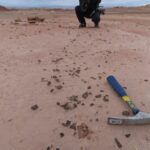
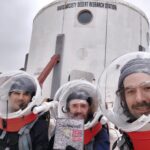
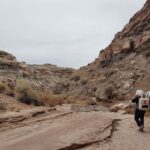

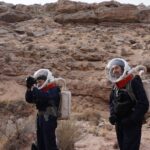
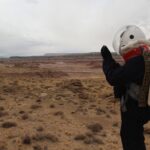
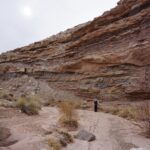
You must be logged in to post a comment.